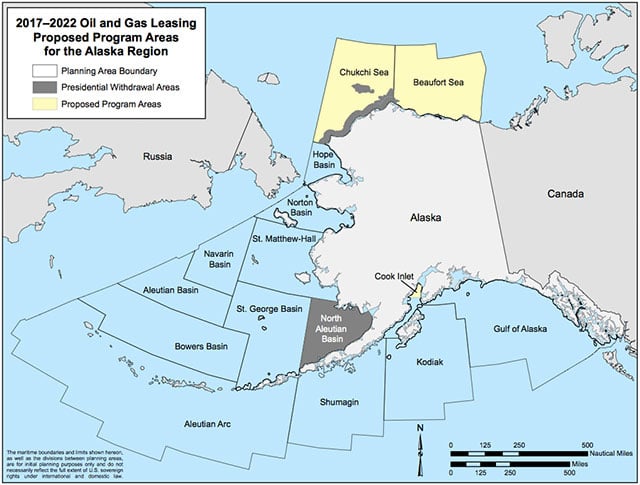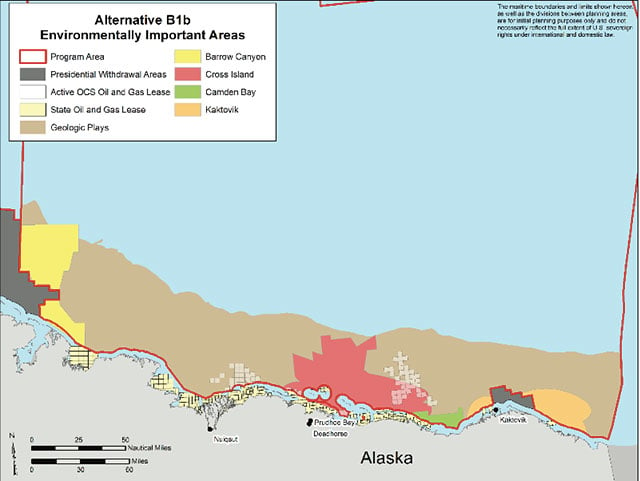
This story was originally published on March 22, 2016 at High Country News.
The Interior Department is decidedly on the fence when it comes to the future of offshore oil and gas leasing in the Arctic and Alaska’s Cook Inlet and is looking for public input on the decision. Last week, the department proposed holding three lease sales in Alaska over five years, but with the caveat that it is leaving open the option of not holding any lease sales at all. It also will consider excluding from leasing offshore areas that are important ecologically or for traditional subsistence fishing and hunting by the Iñupiat people who live on the coast of Alaska’s North Slope.
The indecisive announcement was part of the Interior Department’s proposal for leasing swaths of ocean for oil and gas drilling from 2017 to 2022. Interior Secretary Sally Jewell was much clearer on her plans for the Atlantic and Pacific regions: no new leasing, because of strong public opposition.
As for Alaska, Jewell said the department is weighing concerns expressed by some Arctic communities that drilling could hinder the hunting and fishing that is central to their way of life. Native Alaskans hunt whales, seals and walrus whose marine habitat already is being dramatically altered by climate change. “We’re particularly interested in hearing from the public and Alaska Native communities about whether these areas are appropriate for leasing and what steps we may need to take the protective and important resources found in them,” Jewell told reporters in a conference call.
 (Chart: Courtesy Bureau of Ocean Energy Management)
(Chart: Courtesy Bureau of Ocean Energy Management)
She said the impact of drilling on climate change and industry’s interest in drilling offshore in the Arctic, which has been tenuous, also will figure in. Shell last fallpulled the plug on its Arctic Ocean exploration for the “foreseeable future” because it didn’t find enough oil to warrant the expense of exploring in such a difficult environment, especially given the low price on petroleum. That was bad news for Alaska’s state government, which relies heavily on oil revenues. Low oil prices and declining onshore production already have caused a state budget crisis and Alaska politicians see offshore oil as a potential financial lifeline for the state’s future.
The Bureau of Ocean Energy Management, the Interior Department agency that oversees offshore energy development, held 10 meetings in Alaska communities over recent weeks and plans to seek more input during a 90-day comment period.
 The habitat of the Pacific walrus is rapidly changing as sea ice declines due to climate change. Sea ice gives walruses a place to rest between feedings. (Photo: Sarah Sonsthagen, USGS)
The habitat of the Pacific walrus is rapidly changing as sea ice declines due to climate change. Sea ice gives walruses a place to rest between feedings. (Photo: Sarah Sonsthagen, USGS)
So far, it seems feedback from local communities is mixed. “We’re glad Interior has kept the door open,” says John Boyle, director of government and external affairs for the North Slope Borough, the local government along Alaska’s north coast. “We feel the local voice is often drowned out by national special interest groups.”
Historically, the borough government has advocated for responsible oil and gas development. “We believe the standards and regulations are sufficient” to allow oil and gas development, Boyle says.
Meanwhile, other community leaders adamantly oppose drilling. “We have a very pristine environment that’s at risk,” says Rosemary Ahtuangaruak, the former mayor of a tiny Iñupiat village called Nuiqsut.
 Areas being considered for exclusion from leasing in Beaufort Sea. Nuiqsut is the lower left corner. (Chart: Courtesy Bureau of Ocean Energy Management)
Areas being considered for exclusion from leasing in Beaufort Sea. Nuiqsut is the lower left corner. (Chart: Courtesy Bureau of Ocean Energy Management)
Ahtuangaruak has been trying to educate Arctic people about the many potential environmental impacts of offshore oil and gas drilling, including air and water pollution and large oil spills. A recent BOEM report estimated a 75 percent chance of an oil spill in the Chukchi over 77 years under a scenario of robust offshore oil and gas drilling. Further studies indicate that cleaning up after a spill in the sensitive Arctic environment would be very difficult.
The Arctic leasing areas being considered for exclusion include:
-
Barrow Canyon — A migrating and foraging area for beluga, bowhead and gray whales, as well as seabirds. The canyon, at the nexus of the Chukchi and Beaufort seas, is used for subsistence hunting and fishing.
-
Camden Bay — A prime feeding area for bowhead and beluga whales and seals used by local people for whale hunting in the fall.
-
Cross Island — An important migrating area for bowhead and beluga whales and a denning area for polar bears. It’s also important for subsistence hunting.
-
Kaktovik — Another feeding area for bowhead and beluga whales, which local people hunt.
-
Walrus foraging area — A stretch of the Chukchi Sea used by walruses to travel from shore to Hanna Shoal, an area of shallow water frequented by walruses where food abounds and sea ice lingers well into the summer. Hanna Shoal already was withdrawn from leasing by President Obama.
-
Cook Inlet — Habitat for a population of beluga whales designated as federally endangered.
 Areas being considered for exclusion in Chukchi. (Chart: Courtesy Bureau of Ocean Energy Management)
Areas being considered for exclusion in Chukchi. (Chart: Courtesy Bureau of Ocean Energy Management)
Sen. Lisa Murkowski, R-Alaska, said she was glad that the administration has proposed three lease sales in Alaska as she had demanded. But she called the decision not to lease in the Atlantic, a reversal from an earlier proposal, “an ominous warning to Alaskans.” “As easily as the Atlantic was taken off the table, the proposed sales in the Cook Inlet, Beaufort Sea, and the Chukchi Sea could suffer the same fate in further reviews,” Murkowski said in a statement.
Environmentalists hope that public pressure will sway the Interior Department to reverse its proposal to lease, as it did in the Atlantic. “There is time for this administration to rejigger its course,” says Peter Van Tuyn, an Anchorage-based environmental lawyer.
The administration has not specified when it will make its final decision but some experts predicted an announcement this fall.
Angry, shocked, overwhelmed? Take action: Support independent media.
We’ve borne witness to a chaotic first few months in Trump’s presidency.
Over the last months, each executive order has delivered shock and bewilderment — a core part of a strategy to make the right-wing turn feel inevitable and overwhelming. But, as organizer Sandra Avalos implored us to remember in Truthout last November, “Together, we are more powerful than Trump.”
Indeed, the Trump administration is pushing through executive orders, but — as we’ve reported at Truthout — many are in legal limbo and face court challenges from unions and civil rights groups. Efforts to quash anti-racist teaching and DEI programs are stalled by education faculty, staff, and students refusing to comply. And communities across the country are coming together to raise the alarm on ICE raids, inform neighbors of their civil rights, and protect each other in moving shows of solidarity.
It will be a long fight ahead. And as nonprofit movement media, Truthout plans to be there documenting and uplifting resistance.
As we undertake this life-sustaining work, we appeal for your support. Please, if you find value in what we do, join our community of sustainers by making a monthly or one-time gift.